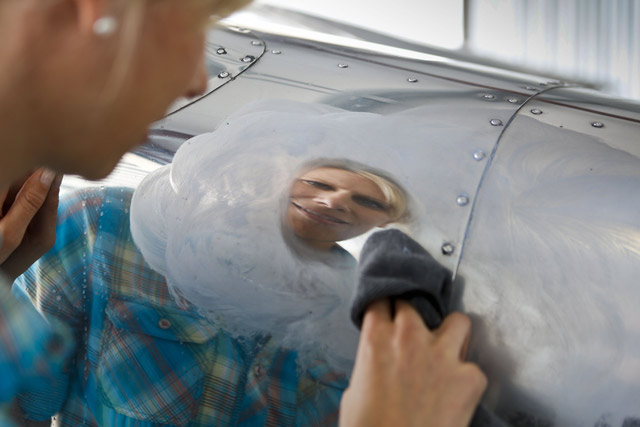Polished aluminum character test

Any polished aluminum airplane presents its owner with a real-life character test—and a constantly updated report card. Does the owner have the commitment, perseverance, consistency, and attention to detail to keep the airplane shining and protected from the elements? Or will the owner’s indifference and neglect be visited on the innocent airplane’s vulnerable skin in the form of oxidation and corrosion?
Polished aluminum aircraft have advantages over their painted counterparts. They’re lighter because they aren’t weighed down by paint, which can add 40 pounds or more to the heft of a typical single-engine aircraft. They also reveal the skill and workmanship of the manufacturer and quality of the components—with striking and aesthetically pleasing beauty.
The downsides of polished aluminum airplanes are that they show every imperfection and flaw, and they require constant vigilance and ceaseless upkeep. Polishing typically takes place quarterly, and it’s a painstaking, repetitive, laborious process that never really ends.
An orbital buffer (along with a variety of buffing pads) is the most essential tool in keeping a bare-metal airplane shiny. A variable-speed buffer with a 6- to 9-inch pad is ideal, and the lighter the unit is, the better—because you’ll be raising it overhead, using it while lying on your back, and in other contorted positions.
Wool pads are the most abrasive and are used for removing major oxidation, but a range of softer pads is available for simple cleaning and polishing. Any auto detail shop will have a full complement. Nuvite, Jetstream, Rolite, Free Flite, and others offer aviation-specific metal polishes that are available online at Aircraft Spruce, and mass-market brands such as Mothers and Meguiars also work well on airplanes.
First, make sure the surface to be polished is clean and free of dirt or fine grit. Then apply metal polish to the skin and attack it with an orbital buffer. Thorough cleaning requires holding the buffer at about a 15-degree angle so that the rotating edge is pressed firmly against the airplane’s skin. Avoid laying the buffer flat when cleaning.
It won’t take long for the metal polish to be transformed into sticky black grit, and that’s a sign of progress. Replace dirty buffing pads as often as you have to. If the airplane surface gets scuffed with circular marks, apply a lighter grade of polish and lay the buffer flat on the skin to remove them.
Once the buffing is finished, raid your pantry for flour or cornstarch; pour it on a clean, soft rag; and rub it on the airplane’s skin to remove any leftover polish. This is best done by hand.
A polished airplane typically will look great for about 90 to 120 days, and then it’s time to repeat the entire cleaning, buffing, and polishing process. It’s a big job, and owners have their own strategies for getting it done. Some prefer to do it continuously by polishing small sections of their aircraft’s skin after each flight. Others get their dirty work done by periodically plying volunteers with pizza, or giving them airplane rides—or both. But owners treasure these sculpted works of art in spite of the hands-on work required to keep them sparkling. And the rest of us simply admire their dedication and effort.
Email [email protected]
 “I polish it after every airshow and it takes about three days to do the entire aircraft by myself.” —Scott Yoak, owner and pilot of Quicksilver, an award-winning (and blindingly polished) P–51 Mustang.
“I polish it after every airshow and it takes about three days to do the entire aircraft by myself.” —Scott Yoak, owner and pilot of Quicksilver, an award-winning (and blindingly polished) P–51 Mustang.


